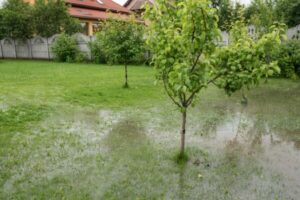It seems as if the rain might never stop here in Georgia, and too much rain can mean big lawn problems for you. Below are five major issues you could find yourself dealing with if your yard does indeed get too much rain.
Fungus
Rainfall and humid conditions are perfect for a variety of fungal issues affecting your turfgrass. Many types of fungi grow in warm, damp places, and is particularly problematic in warm temperatures. If your lawn has brown patches, this is due to a fungal infection. Brown spot fungus is very common during rainy summers when temperatures remain warm for long periods.
Luckily, many fungal diseases are treatable with a fungicide program. Tee Time offers two types of fungus prevention. Our 3-Step Preventative Fungus Program is designed for lawns that have a known fungus issue that recurs yearly. In contrast, Our 2-Step Curative Fungus Program is designed for customers who are not sure if their yard will develop fungus each year but need to treat their lawn. Both programs are effective in treating fungal lawn care issues. Our Tee Time experts can help you decided which program is best for you.
Pests
Many pests thrive in the rainy weather. Insects like mosquitoes breed when it is wet because they need standing water to lay their eggs. Places like puddles, flower pots, birdbaths, and other containers filled with water make great spots for eggs. Heavy rainfall encourages other pests to breed, especially fleas and ticks. Heavy rain can also raise issues when keeping pests out of your home. The tiniest cracks in the foundation or siding will cause insects and pests to seek shelter inside your home during the rainy weather.
Pest infestations should be treated quickly to prevent any damages made inside and outside your home. Tee Time offers many solutions to lawn care problems from too much rain, including pest control services, from controlling pesky mosquitoes, fleas and ticks, to controlling ants, spiders, millipedes, and everything in between.

Root Damage
Plant roots need air to survive and flourish. When there is too much water in the soil due to heavy rainfall, plant roots do not receive the air they need to grow. A typical result of this is that plants begin to turn yellow, drop leaves, wither, and die. Lawns will typically show spotty areas of dead grass.
Loss of Nutrients
Heavy rainfall can wash away nutrients before they can be absorbed in the lawn. When the water saturates the grass, it loses the nutrients that the lawn needs and will leave it weak and dull. While too much rain can drown your grass, weeds thrive in these wet conditions.
Because your grass is not getting the nutrients it needs, you will have to use additional fertilizer to compensate. Tee Time Lawn Care’s lawn fertilization plan will help your lawn bounce back to its green and healthy look while controlling weed growth.
Erosion
Water flowing through properties is typical in periods of heavy rainfall. As the water is running downhill, it is washing away good soil and causing a groove in your yard. Turfgrasses typically hold on to the ground, but the excess water has weakened these roots, leaving nothing to prevent the water flow.
If you find yourself with any of these issues, be sure to call us at Stone Creek Landscaping. Below are a few areas of our expertise:
- Lawn Maintenance
- Landscape Maintenance
- Lawn Fertilization
- Irrigation
- Clean up Work
- Tree Service
- Landscaping Drainage
- Planting and Mulch
